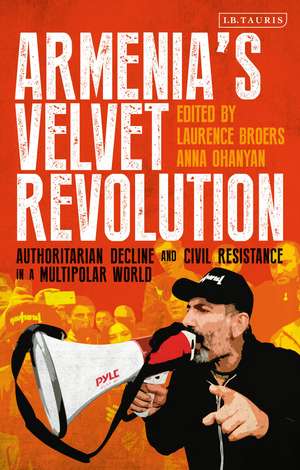Armenia’s Velvet Revolution: Authoritarian Decline and Civil Resistance in a Multipolar World
Editat de Anna Ohanyan, Laurence Broersen Limba Engleză Paperback – 2 sep 2020
| Toate formatele și edițiile | Preț | Express |
|---|---|---|
| Paperback (1) | 159.53 lei 3-5 săpt. | +27.82 lei 6-12 zile |
| Bloomsbury Publishing – 2 sep 2020 | 159.53 lei 3-5 săpt. | +27.82 lei 6-12 zile |
| Hardback (1) | 497.41 lei 6-8 săpt. | +46.44 lei 6-12 zile |
| Bloomsbury Publishing – 2 sep 2020 | 497.41 lei 6-8 săpt. | +46.44 lei 6-12 zile |
Preț: 159.53 lei
Preț vechi: 173.36 lei
-8% Nou
Puncte Express: 239
Preț estimativ în valută:
30.53€ • 31.94$ • 25.36£
30.53€ • 31.94$ • 25.36£
Carte disponibilă
Livrare economică 13-27 martie
Livrare express 26 februarie-04 martie pentru 37.81 lei
Preluare comenzi: 021 569.72.76
Specificații
ISBN-13: 9781788317177
ISBN-10: 1788317173
Pagini: 288
Dimensiuni: 138 x 216 x 19 mm
Greutate: 0.34 kg
Editura: Bloomsbury Publishing
Colecția I.B.Tauris
Locul publicării:London, United Kingdom
ISBN-10: 1788317173
Pagini: 288
Dimensiuni: 138 x 216 x 19 mm
Greutate: 0.34 kg
Editura: Bloomsbury Publishing
Colecția I.B.Tauris
Locul publicării:London, United Kingdom
Caracteristici
Will appeal to Armenia's wide diaspora - with significant population in the US
Notă biografică
Anna Ohanyan is a Fulbright Scholar (2012-13) and the Richard B. Finnegan Distinguished Professor of Political Science and International Relations at Stonehill College in Massachusetts. She is the author of Networked Regionalism as Conflict Management (Stanford University Press, 2015) and editor of Russia Abroad: Driving Regional Fracture in Post-Communist Eurasia and Beyond (Georgetown University Press, 2018). Professor Ohanyan has published widely on global governance, security studies and conflict management in scholarly and policy journals, and has consulted for the UN Foundation, World Bank, National Intelligence Council Project at Maryland University, the US Department of State, the Carter Center, and USAID.Laurence Broers is a research associate at SOAS in London, and an associate fellow at the Royal Institute for International Affairs at Chatham House. He has a decade's experience as a practitioner of peacebuilding and human rights advocacy in the South Caucasus, and his research interests include intractable conflicts and peacebuilding in post-Soviet Eurasia, the politics of unrecognised states, and the critical geopolitics of post-Soviet space. He is the author of Armenia and Azerbaijan: Anatomy of a Rivalry (Edinburgh University Press, forthcoming) and the co-editor of The Unrecognised Politics of De Facto States in the Post-Soviet Space (Caucasus Institute, 2015) and Networked Insurgencies and Foreign Fighters in Eurasia (Routledge, 2018). He is also co-founder and chief editor of the triannual journal Caucasus Survey.
Cuprins
Foreword - Salpi GhazarianIntroduction: An unlikely transition? - Laurence Broers Chapter 1. Velvet is not a colour: Armenia's democratic transition in a global context - Anna OhanyanChapter 2: Thirty years of protest: how Armenia's legacy of political and civic protests prepared the Velvet Revolution - Mikayel ZolyanChapter 3. How Serzh Sargsyan and the Republican Party of Armenia lost control of a competitive authoritarian system- Laurence BroersChapter 4: Armenian civil society: growing pains, honing skills and possible pitfalls - Jenny PaturyanChapter 5. Donning the Velvet: Nonviolent resistance in the 2018 Armenian Revolution - Jonathan PinckneyChapter 6. Armenia's transition: The challenges of geography, geopolitics and multipolarity - Richard GiragosianChapter 7. Preserving the alliance against tall odds: Armenia's Velvet Revolution as a challenge to Russia - Pavel K. BaevChapter 8. Political patriarchy: Gendered hierarchies, paternalism, and public space in Armenia's 'Velvet Revolution' - Tamar ShirinianChapter 9: Democratization and diaspora: The Velvet Revolution and the Armenian nation Abroad - Kristin CavoukianConclusion: What's Next? Authoritarian Reserves and Risks in a Democratic State - Anna OhanyanIndex
Recenzii
In a time when democracies are in decline and authoritarian populism spreads its illiberal shadow from Erdogan's Turkey to Modi's India to Trump's America, a light from Armenia pierces the growing political darkness. Begun as a march on the capital and legitimized in free and fair elections, a non-violent, democratic, civilly disobedient movement took power in Yerevan and carried out a determined cleansing of an arrogant and corrupt power structure. While the evident decay of democracy across the globe speaks to the fragility of liberalism, this excellent volume demonstrates that authoritarian regimes have deep-seated weaknesses that can undermine the dominion of venal elites and unleash aspiring democratic forces. The post-Soviet Armenian state, alone in a dangerous neighborhood, at war with one neighbor and threatened by another, substituted security for freedom. Yet a courageous and resistant civil society never fully succumbed to the usurpation of the promise of progress. As the authors within and outside Armenia eloquently elaborate in this collection, non-violent resistance can lead effectively toward a democratic outcome
This is the definitive history of Armenia's Velvet Revolution. The volume provides context, analysis, and nuance regarding Armenia's impressive show of people power in 2018, and prospects for longer-term transformation. Kudos to the editors and authors of this masterful collection.
This is the definitive history of Armenia's Velvet Revolution. The volume provides context, analysis, and nuance regarding Armenia's impressive show of people power in 2018, and prospects for longer-term transformation. Kudos to the editors and authors of this masterful collection.
